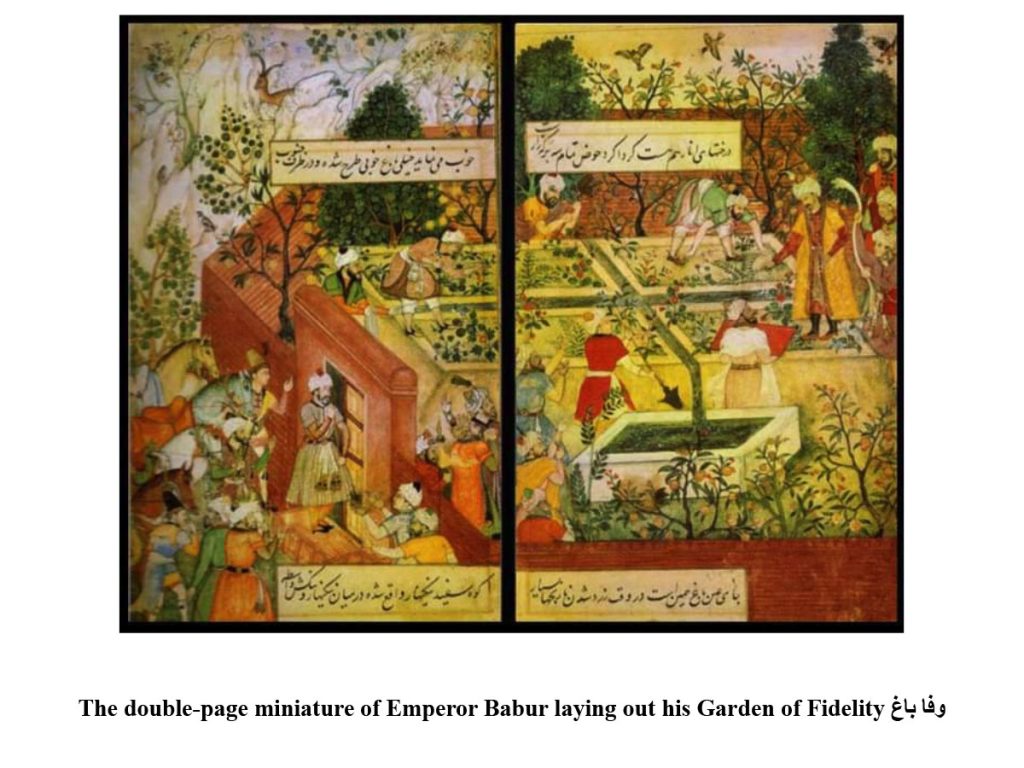
I start with two points. First, it is generally believed that knowledge of Indian gardens and garden landscapes is based upon Timurid and Mughal per se Persian practises of garden culture. This was because gardens in those times especially evolved as social spaces that were designed, used, enjoyed, and appreciated. It is the garden culture rather than merely the gardens as physical sites which needs to be understood.
Second, it is also believed that the concept of the Islamic garden developed by the Muslim sultans finds its source in the term jannat ul firdaus used in the Holy Quran. If we further probe these most believed theories, we realize that the concept of an Islamic garden finds credence both in the Indic and Islamic texts of the Indian sub-continent, although it was differently represented.
Hypothetically speaking, jannat ul firdaus, the fundamental Islamic conception of paradise as a garden, is the original classic on which the model of the earthly gardens was based. The profound sacred symbolism of the jannat ul firdaus comes from the Sura xviii. 107, which reads, “Those who believe and do the things that are right, they shall have the Gardens of Paradise for their abode.” In this regard, the Mughals and the sultans of the Deccan were perfect examples of making their palaces, mosques and tombs into ‘paradises’ on earth.
The imagery of an Islamic garden’s archetype had distinct constituent elements of a variety of flowers and fruits like roses, jasmines, tulips, daffodils, lilies, medicinal plants, singing birds, pavilions, water bodies, rivers and many such ideas that signified eternal life. This was a conventional image of paradise which became an earthly representation of a paradise garden which was in line with the cultural essence of Islam. Even though the Quran does not describe the layout of a garden, the four rivers of water, wine, milk and honey equated with the Saihan (Syr Darya), Jaihan (Amu Darya), Furat (Euphrates) and Nil (Nile) are construed to be a depiction of a compartmentalized garden on earth—the chahar bagh, a quadrilateral layout with four smaller gardens divided by walkways or flowing water, a typical Persian tradition.
The following miniature painting is a beautiful representation of a chahar bagh model called the Bagh-i-Wafa constructed by Babur in 1508-09 which finds reference in his memoirs, the Babur Nama. He says, “It overlooks the river, which flows between the fortress and the garden. It yields many oranges, citroens and pomegranates. I had plantains planted there. The year before I had sugarcane planted there. The garden lies high, has running water close at hand, and a mild winter climate.
In the middle of it, a one-mill stream flows constantly past the little hill on which are the four garden plots. In the southwest part of it there is a reservoir ten by ten, around which are orange-trees and a few pomegranates, the whole encircled by a trefoil meadow. This is the best part of the garden, a most beautiful sight when the oranges take color.”

At another place in his memoirs, Babur makes a remark about the lack of flowing water in some parts of South Asia, which was a pre-requisite for the chahar bagh, so Babur and his successors tackled this challenge by building terraced chahar baghs to force the flow of water. This was in contrast to the Safavid chahar bagh that were often built on a single plane. The miniature above well depicts this engineering feat.
The basic design of the paradise garden was very simple. Water, symbolically and physically, formed the source of life which was seen in the water channels crossing at the centre of the garden dividing the rectangular or square area into four quarters. The crossing of water channels represented the four rivers of life and also symbolized the meeting of humanity and God as portrayed in many religions. On each side of these channels, were planted a straight line of trees while the quarters may have also been filled with trees and flowers.
Sometimes the trees extended at each side of the garden to form woodlands.
A more complex symbol not found in earlier Persian gardens was the octagonal design much used by the Mughals in the Indian sub-continent. It evolved from the squaring of the circle, symbolizing the coming together of humans represented by the square with the circle of eternity. Gardens divided into eight parts were taken to represent the eight parts of the Qur’an. Even the measurement of constructing water tanks ten cubits by ten cubits was supposed to have had a religious significance. This was the measurement prescribed for ablution tanks used by the devout Muslims before offering prayers. Hence, the basic characteristics in all Islamic gardens was their geometric symmetry interlaced with free plant growth, spring flowers growing informally, roses spraying over water tanks, and trees branching in their natural forms.
In the nineteenth century, archaeologists and scholars approached monuments as standalone structures rather than relating to the larger space which encompassed gardens; and Western writers have long seen the Islamic garden as an earthly reflection of paradise, an ultimate destination of the faithful. However, such simplification, as D. Fairchild Ruggles contends, denies the sophistication and diversity to the art form. There is a need to move beyond the Persian or Timurid model of the paradise garden as the garden was connected to wider locales and environment. The geometric pattern of chamans was found in the old Rajput gardens at Amber and common traditions of water, vegetation, and architectural symbolism were seen in the gardens laid out by the Mughals and the earlier Indian gardens.
The Islamic garden, developed on the lines of paradise, was not a uniquely Persian idea, although it developed under the Persians and became an art and a tradition involving a deep love for trees and flowers. It is interesting to note that Xenophon, a Greek philosopher-historian in 401 BCE describes how his contemporary Cyrus the Younger (a Persian prince and general) planted a garden with his own hands carefully setting out a straight line of trees. Another example is that of Xerxes of the Achaemenid Empire who admired a chenar tree so much that he hung gold amulets upon its branches. Khusro II, the Sasanian king of Persia in 590 CE developed a paradise garden spread over 300 acres and the Ummayads in 750 CE indulged in crafting out paradise gardens.
While the Persian tradition has been one of the main forces in the evolution of the paradise garden, it is seen from the examples mentioned above that its origins are far older than the rise of Islam and the formation of empires in Persia. The earliest reference to the paradise garden is described in the book of Genesis (the first book of the Hebrew Bible and the Old Testament): “And a River went out of Eden to water the garden; and from thence it was parted and became into four heads.” This was the basic essence of a paradise garden where the material and the spiritual met.
Daud Ali and Emma J Flatt’s edited work on garden culture highlights the subtle and focussed references to gardens found in some of the literary texts of the Deccan sultanates in particular which provide crucial information about domesticated garden spaces, agricultural landscapes, irrigational technologies, and the merits of planting gardens.
Real gardens were seen in built surroundings of cities, palaces, tombs, and imaginary gardens were depicted in cosmological spaces of paintings and poetry.
Interestingly, astrological and magical theories and practices prevalent in parts of the medieval Deccan had an impact on the general garden culture of the region. The illustrated encyclopedia Nujum ul-Ulum (The Stars of the Sciences), presently housed in the Chester Beatty library in Dublin prepared under the Adil Shahis of Bijapur, has a specific chapter on gardens with a description of sowing seeds, the eastern wind and medicines for pests.
Similarly, Ponnaganti Teleganarya in the Telugu treatise Yayati Charitramu written during the Qutb Shahi times mentions that the garden developed by Abdul Qadir Amin Khan was one of the seven meritorious acts which were thought to enhance a nobleman’s prestige traditionally referred to in Telugu classical traditions as the saptasantanam. The idea of the saptasantanam has its origins in the ancient inscriptions commonly written in Sanskrit, Prakrit or Dravidian languages.
Thus, paradise gardens of the Deccan sultanates and Mughal India are to be understood in two related ways: first, as real or imagined spaces and landscapes that were mandated to have great visual appeal and second, as a mixed collection of traditions and practices having lasting social implications on people who visited them to witness nature’s celebration of its beauty. Since most research till date has concentrated on the comparatively well preserved gardens and built landscapes of the celebrated Muslim states, this opens up a whole new and exciting area of enquiry for those working in this direction. If comparative research on this subject is undertaken by horticulture designers and classically trained scholars, it will contribute to a constructive reweaving of scholarly and practical interest in the garden culture of the Indian sub-continent.
Salma Ahmed Farooqui is Professor at H. K. Sherwani Centre for Deccan Studies, Maulana Azad National Urdu University, Hyderabad. She is also India Office Director of the Association for the Study of Persianate Societies (ASPS).

